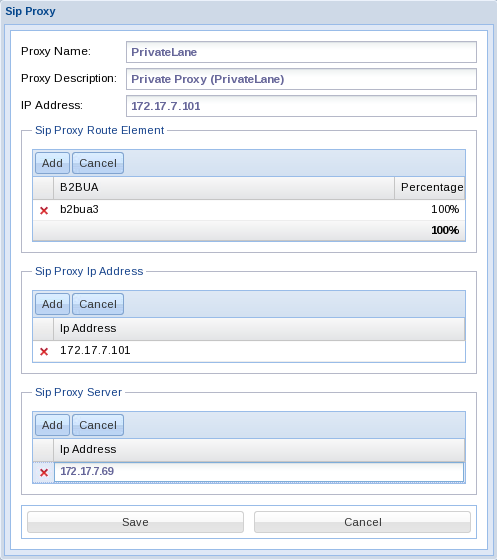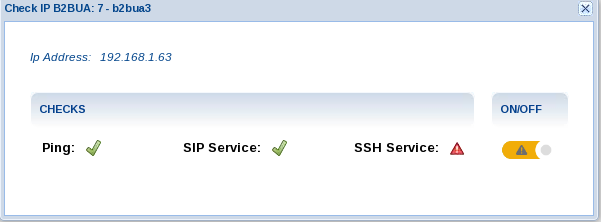System
SYSTEM
In this chapter, technical details of the network topology described in chapter 1 are managed.
SIP Proxy
This table defines the SIP proxies that will handle the calls. The proxies serve as the public face of the SKY DANCE system.
Note: You will want to setup the list of B2BUA's in the system prior to adding proxies.

Click the checkbox of the proxy you want to edit and click the edit button to edit it. The following screen will be displayed.

In the Sip Proxy Route Element, each b2bua that will be used for media handling and routing can be setup, along with the percentage of traffic that each should be allocated.
The SIP Proxy IP Address list is used to setup which address or addresses the SIP Proxy will listen on for incoming calls (172.17.7.69). Note that the listen port for the proxy is currently always 5060.
The SIP Proxy Server Section is used to list the OAM&P addresses (172.17.7.69) that will be used for secure shell access to the server which physically hosts the proxy.
Once you are done, click Save to save your changes.
SIP B2BUA
This table defines the list of B2BUAs associated with the SIP Proxies. Sky Dance uses the B2BUA or Session Controller element to handle media translations, for routing and as a central element for running custom applications.
Note: This table should be created before the proxy table, as the proxy table depends on it.

You can check whether the various services SIP, ssh etc. are working on the IP addresses you have setup by clicking on the information icon ![]() on the right side of the row.
on the right side of the row.
The following screen will be displayed:

SIP Route Server
Sky Dance Routing Servers are used by the B2BUA/SBC element to determine which route to use for outbound calls. This is done using a SIP 302 Redirect query to the Routing Server. Routing Servers can be grouped into clusters for redundancy.

You can add and delete routing servers of the list by using the corresponding buttons.
SIP Route Server Cluster
In the process, the Back to Back User Agent â queries the routing servers and in return, the routing servers will deliver the list of qualified suppliers to terminate the call. In this table the pair of routing servers that the B2BUA query, are defined.

The percentage of calls a B2BUA will consult to a routing server or the other is defined in the SIP Route Server Cluster. For example, in row 1 of figure 39 the User Agent queries the routing server Madrid and Miami in the same percentage of calls.
You can add and delete SIP Routing Server Clusters of the list by using the corresponding buttons.
The cluster that is in use for routing is located in:
/usr/local/scripts/dedalus/routing_functions.lua MYSELF